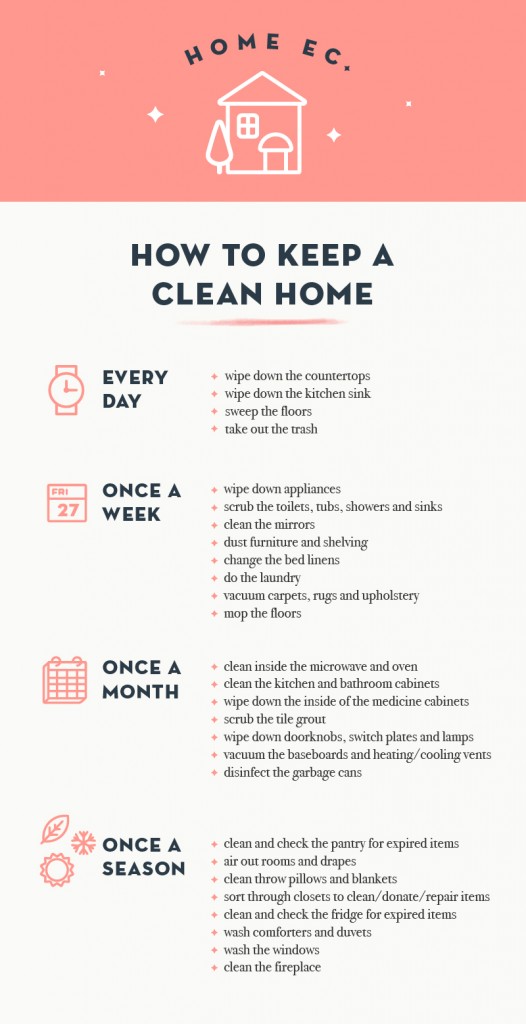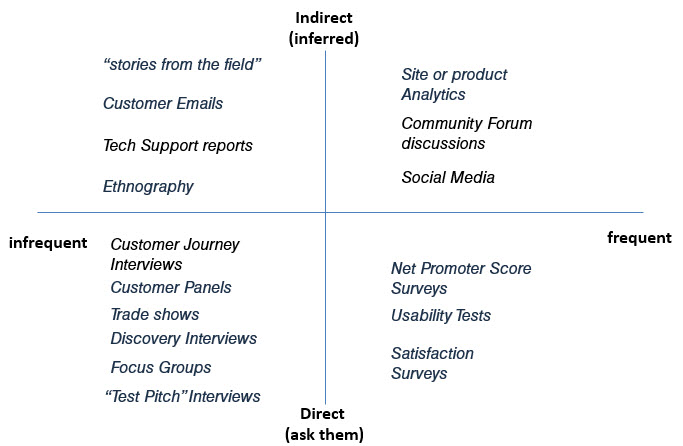Just in time for “spring cleaning”, my real estate agent sent me this very helpful list on how to keep a clean home. I’m not sure, I suspect it may have been a comment on the state of my house.
I’m not much of a housekeeper so I switch the “daily” to “weekly”, The “weekly” to “monthly”, the “monthly” to “umm… I think I saw something move”, and the “once a season” to “when I move” (hence my realtor’s interest).
That said, I do like the idea of keeping to a schedule. There are some things that you do every once in a while, and some things you need to do more frequently.
I noticed my car owner’s manual has a similar approach.
Break-in service: after 2,000 km (that’s 1,200 miles for you non-metric folks)
Oil/filter change: every 5,000 – 10,000 km
Break fluid flush: every 2 years
And so forth…
When it comes to Voice of Customer programs, many organizations get overwhelmed by the number of methods and approaches that they can take. Should they do a survey? Social media analysis? Interviews? Focus groups? Customer Panels? Analyze their site/product analytics? Should we be doing this “big data” thing?
There are so many different options that sometimes organizations become paralyzed with indecision. Or, more insidiously, they try to cram in ALL customer learning into one vehicle. “We’re doing a survey? Great, let’s ask them about these twenty other things we’re dying to know”.
It’s not a sprint. You wouldn’t do all your housecleaning all in one go, and you wouldn’t maintain your car that way either.
A good Voice of Customer program takes a similar approach. There are things you should do when you first launch a product or service, or when your customer first gets your product. The “Break-in Service” if you will. Then then are things that you should do every week, every month, every quarter, every year or two.
I find it useful to think of customer listening along two different dimensions. One is how direct the technique is. Direct techniques involve asking the customer directly about something. Those techniques include things like surveys and interviews. Indirect techniques are ways that you might infer your customers’ needs, thoughts and desires through quietly observing them. These might include things like ethnography, website analytics, or social media monitoring.
Another dimension is how frequently you might perform the activity. Frequent activities might include customer satisfaction surveys every time a customer completes a transaction, usability testing, or Google analytics (depending on your site traffic). Infrequent activities might include customer journey mapping, customer panels, or ethnography.
When you map out different techniques into quadrants, you get something that looks like this.
As a good rule of thumb, it is useful to do one technique out of every quadrant. Unless you are a very large organization, you won’t have the resources to do all of these. The specific tool you use will depend on the specifics of your business and product.
Maintaining a customer-centered organization requires constant attention. You can’t achieve it by creating a task force once a year that goes around and points fingers at people. Just like you wouldn’t expect your car to run smoothly if you launched a “car quality initiative” once every 12 months.
The good news is that it doesn’t have to be onerous. You don’t have to do everything at once. Pick a few things that make sense for you, put yourself on a schedule, and do it regularly. Your customers will thank you.





![[Research Round-Up] New Study Shows the Continuing Value of B2B Thought Leadership](https://customerthink.com/wp-content/uploads/development-2010010_1280-pixabay-innovation-ideas-think-1-218x150.jpg)
Hi Jana,
Does anyone actually change their bed linens every week?!
Your point about conducting Voice of the Customer initiatives on a regular basis has an added advantage – it keeps the customer, and the customer experience top-of-mind. With this more regular “thinking about the customer,” employees are more likely to treat the customer in a more positive way on a more consistent basis.
Your scheduling approach can create a virtuous cycle.
Best regards,
Jim Watson
Portland, Maine
http://www.mylifeasacustomer.com
Hi Jim, that’s exactly how I reacted to that schedule! I asked around and it turns out that some actual human beings do this.
Consistency is so key to so many things. From exercise to maintenance to Voice of Customer programs.
Thank you for your thoughtful comment!
– Jana
Hey Jana,
Humourous and insightful as always. I really like how you connected the schedule of everyday life with that of customer engagement.
Cheers,
Dave
Hi David, thanks for the kind words! Glad you enjoyed it!
Hi Jana,
Thanks for the approachable overview to VoC, and the clarity you’ve provided through the quadrant approach. I’m sure it will be a helpful guide for client-side program owners.
You’ve touched upon a couple of important points:
1) Too often, organizations attempt to gather everything they can possibly think of through a customer survey. Unfortunately, it dilutes survey effectiveness and drives down customer participation and response rates.
2) Effective VoC programs take the long view…consistency and continuity in gathering insights is key… and of course, enabling the organization to take action and affect positive change based on VoC program results.
Thanks for your advocacy of the VoC industry!
Best,
Jeff Hall
President
Second To None
http://www.second-to-none.com
Hi Jeff,
Thanks for this comment. You are exactly right. I see the survey-of-a-thousand-questions approach many times – and it NEVER gives the results people hope for.
Consistency is key!
– Jana
http://AuthenticInsight.com